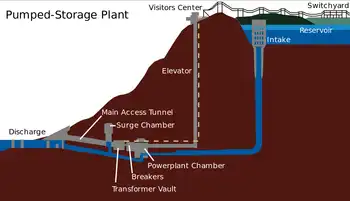Failed experimental energy plant costs millions
CARSON CITY, NEVADA - A major Nevada utility got more than $200 million in taxpayer and ratepayer dollars for an experimental clean-coal generating plant that wouldn't run reliably and was mothballed. Now, Sierra Pacific Power Co. wants $42 million more from its customers.
More than half of the funding targeted for the Pinon Pine gasified coal project came from the federal Department of Energy, according to Sierra Pacific documents.
An Associated Press survey of Energy Department records shows it's a prime example of investments of public funds in failed alternative energy ventures around the nation.
Construction on the Pinon Pine project, part of the utility's Tracy power station east of Reno, began in early 1995. The project, plagued by cost overruns, came on line in late 1996 — but as a conventional, gas-fired power plant. The experimental gasified coal system was shut down. Total costs for the entire plant ran more than $340 million.
The gasification process converts solid coal to a synthetic natural gas that can be burned as a fuel to turn electricity-generating turbines. The idea was to create more efficiency and less pollution, but a series of equipment problems resulted in aborting all startup attempts, according to PUC records.
A gray dome and steel framework that were part of the experimental Pinon Pine project are still standing and will have to be torn down. Sierra Pacific Power continues to run the conventional side of the plant, and is expanding other gas-fired generating facilities at its Tracy station.
Besides the $168 million the Reno-based utility got from the federal Energy Department, Sierra Pacific already has been authorized by the PUC to collect more than $110 million from its ratepayers for both the conventional and experimental Pinon Pine projects.
The state Public Utilities Commission has scheduled a Jan. 9-11 hearing on the bid by Sierra Pacific Power to get the additional $42 million. The commission previously denied the request but the utility appealed and won a court order in 2006 that led to the new commission hearings.
Because the money to be collected is being spread over several years, the impact on customers' monthly bills has been slight. If the company wins its latest request, the average residential customer would pay about $2 to $3 a month for the failed part of the Pinon Pine project, according to the company.
Still, the state's consumer advocate for utility customers says enough is enough and the request should be rejected.
"I think they've already been allowed enough recovery on this project, and more recovery would be excessive and I don't think it's justified," Eric Witkoski said.
Witkoski said Sierra Pacific Power is filing another rate increase request, for costs related to another gas-fired generating plant, for millions of dollars more, and regulators "need to be diligent and not allow requested increases that can't be justified."
Sierra Pacific Power attorneys, in a brief filed in support of the $42 million request, say the utility's decision to try the gasification technology was "prudent as a matter of law" and Sierra is entitled to recover all its "just and reasonable costs."
Attorneys Elizabeth Elliot and Julia Sullivan said Sierra Pacific made extensive efforts to closely monitor the project and try to control its costs.
They said Witkoski's office and the PUC's own regulatory operations staff "focused upon narrow, technical arguments" to press for disallowing the $42 million.
Mary Simmons, vice president of external affairs for Sierra Pacific, says the experimental project isn't viewed by the utility as a total failure because "it advanced the country's knowledge and the world's knowledge about what works and what doesn't."
Simmons also said the utility is hoping the technology that didn't work for the Pinon Pine project a decade ago will improve so that it might be used in future years at a proposed coal-fired Ely power plant. Sierra Pacific's parent company, Sierra Pacific Resources, announced this week that it was pushing back the target date for the Ely plant and accelerating plans to expand a natural gas-fired power plant near Las Vegas.
The $168 million in federal Department of Energy funding for the failed Pinon Pine project is among tens of billions of dollars in government spending on alternative energy and energy conservation ventures since 1980 — including many that the department's own inspector general found to be poorly overseen.
Besides the $168 million to Sierra Pacific Power, an AP review of records on such "demonstration" grants shows the Energy Department paid out about $70 million to private lenders after the parent company of an ethanol-refining firm in Louisiana went bankrupt. The DOE sold the plant for scrap for $3 million.
In Tennessee, the Energy Department paid out about $68 million to lenders that backed an ethanol plant that could generate only about half of its expected production. The plant was dismantled and sold for about $10 million.
In another example of green energy gone wrong, the DOE spent nearly $40 million to launch a biomass project in Vermont. The plants operators declared bankruptcy and the 10-story structure now stands abandoned.
Related News

Current Model For Storing Nuclear Waste Is Incomplete
COLUMBUS - The materials the United States and other countries plan to use to store high-level nuclear waste will likely degrade faster than anyone previously knew because of the way those materials interact, new research shows.
The findings, published today in the journal Nature Materials (https://www.nature.com/articles/s41563-019-0579-x), show that corrosion of nuclear waste storage materials accelerates because of changes in the chemistry of the nuclear waste solution, and because of the way the materials interact with one another.
"This indicates that the current models may not be sufficient to keep this waste safely stored," said Xiaolei Guo, lead author of the study and…




